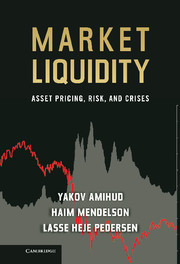Book contents
- Frontmatter
- Contents
- Acknowledgments
- Introduction and Overview of the Book
- Part I The Effect of Liquidity Costs on Securities Prices and Returns
- Chapter 1 Asset Pricing and the Bid–Ask Spread
- Chapter 2 Liquidity, Maturity, and the Yields on U.S. Treasury Securities
- Liquidity, Maturity, and the Yields on U.S. Treasury Securities*
- Chapter 3 Market Microstructure and Securities Values: Evidence from the Tel Aviv Stock Exchange
- Market Microstructure and Securities Values Evidence from the Tel Aviv Stock Exchange*
- Part II Liquidity Risk
- Part III Liquidity Crises
- References for Introductions and Summaries
- Index
Chapter 1 - Asset Pricing and the Bid–Ask Spread
Summary and Implications
Published online by Cambridge University Press: 05 December 2012
- Frontmatter
- Contents
- Acknowledgments
- Introduction and Overview of the Book
- Part I The Effect of Liquidity Costs on Securities Prices and Returns
- Chapter 1 Asset Pricing and the Bid–Ask Spread
- Chapter 2 Liquidity, Maturity, and the Yields on U.S. Treasury Securities
- Liquidity, Maturity, and the Yields on U.S. Treasury Securities*
- Chapter 3 Market Microstructure and Securities Values: Evidence from the Tel Aviv Stock Exchange
- Market Microstructure and Securities Values Evidence from the Tel Aviv Stock Exchange*
- Part II Liquidity Risk
- Part III Liquidity Crises
- References for Introductions and Summaries
- Index
Summary
This article establishes the theory on the effect of liquidity on asset values and provides estimations of the relation between expected returns and liquidity across different stocks. The Amihud–Mendelson model gives rise to two major empirical predictions that are discussed in this chapter's introduction: expected asset returns increase in the assets’ trading costs and the return–trading cost relation is concave. The first prediction results from the fact that investors demand a higher compensation for bearing higher trading costs. The second is due to the clientele effect: because less liquid assets are held in equilibrium by investors with longer holding periods, the additional compensation they require for an increase in trading costs is lower.
The Amihud–Mendelson model shows that, in equilibrium, the return on an asset whose trading is costly is equal to the return that would be earned on a similar-risk asset that is perfectly liquid (entailing zero trading costs) plus a return premium that compensates investors for the transaction costs they bear. That return premium is an increasing function of the expected trading cost per unit of time, which is the product of the asset's transaction cost by the frequency of asset sales. Consequently, higher trading costs lower asset prices because when discounting an asset's cash flow (dividend) at a higher rate of return due to higher trading costs, its value is lower. That is, higher trading costs produce an asset price discount.
- Type
- Chapter
- Information
- Market LiquidityAsset Pricing, Risk, and Crises, pp. 9 - 46Publisher: Cambridge University PressPrint publication year: 2012
- 3
- Cited by



